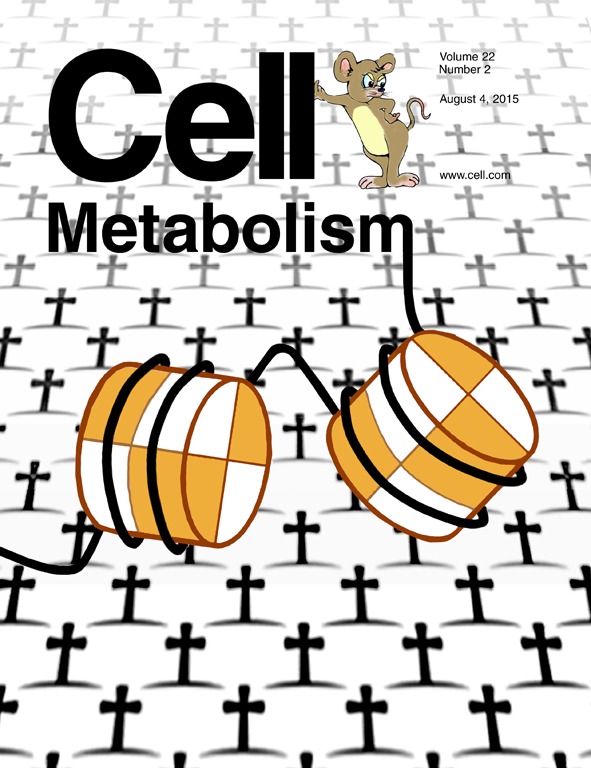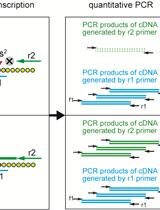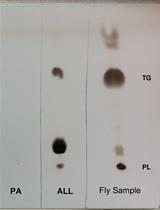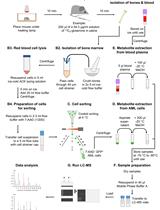- EN - English
- CN - 中文
Quantification of 2-Hydroxyglutarate Enantiomers by Liquid Chromatography-mass Spectrometry
液相色谱质谱法量化2-羟戊二酸对映体
发布: 2016年08月20日第6卷第16期 DOI: 10.21769/BioProtoc.1908 浏览次数: 11628
评审: Masahiro MoritaShannon RuppertPamela Maher
Abstract
Two enantiomers of 2-hydroxyglutarate (2HG), L (L2HG) and D (D2HG), are metabolites of unknown function in mammalian cells that were initially associated with separate and rare inborn errors of metabolism resulting in increased urinary excretion of 2HG linked to neurological deficits in children (Chalmers et al., 1980; Duran et al., 1980; Kranendijk et al., 2012). More recently, investigators have shown that D2HG is produced by mutant isocitrate dehydrogenase enzymes associated with a variety of human malignancies, such as acute myeloid leukemia, glioblastoma multiforme, and cholangiocarcinoma (Cairns and Mak, 2013; Dang et al., 2009; Ward et al., 2010). By contrast, we and others have shown that L2HG accumulates in response to cellular reductive stressors like hypoxia, activation of hypoxia inducible factors, and mitochondrial electron transport chain defects (Oldham et al., 2015; Reinecke et al., 2011; Intlekofer et al., 2015; Mullen et al., 2015). Each enantiomer is produced and metabolized in independent biochemical pathways in reactions catalyzed by separate enzymes and utilizing different cofactors with presumably different consequences for cellular metabolism (Kranendijk et al., 2012). Therefore, as research into the roles of D2HG and L2HG in human metabolism continues, it becomes increasingly important for investigators to consider each enantiomer independently (Struys, 2013). Several methods for quantification of biochemically relevant enantiomers in general have been developed and typically include enzymatic assays using enzymes specific for one enantiomeric species or the other, the use of chiral chromatography medium to facilitate chromatographic separation of enantiomers prior to spectroscopy, or the use of chiral derivatization reagents to convert a mixture of enantiomers to diastereomers with differing physical and chemical properties facilitating their chromatographic separation. In this protocol, we report the adaptation of a previously published derivatization method using diacetyl-L-tartaric anhydride (DATAN) for the quantification of 2HG enantiomers (Figure 1) (Oldham et al., 2015; Struys et al., 2004).
Figure 1. Reaction scheme for the derivatization protocol
Materials and Reagents
- Screw cap 2 ml microcentrifuge tubes (Fisher Scientific, catalog number: 21-403-200 )
- D-2-hydroxyglutaric acid disodium salt (Sigma-Aldrich, catalog number: H8378 )
- L-2-hydroxyglutaric acid disodium salt (Sigma-Aldrich, catalog number: 90790 )
- Sodium lactate (Sigma-Aldrich, catalog number: L7022 )
- Water (LC-MS grade) (Thermo Fisher Scientific, catalog number: W6 )
- [13C4]-2-oxoglutaric acid disodium salt (Cambridge Isotope Labs, catalog number: CLM-4442 )
- Methanol, Optima (LC-MS grade) (Thermo Fisher Scientific, catalog number: A454 )
- Diacetyl-L-tartaric anhydride (DATAN) (Sigma-Aldrich, catalog number: 358924 )
- Acetonitrile, Optima (LC-MS grade) (Fisher Scientific, catalog number: A955 )
- Acetic Acid, Glacial (Fisher Scientific, catalog number: BP2401 )
- Formic Acid, Optima (LC-MS grade) (Fisher Scientific, catalog number: A117 )
- Ammonium Hydroxide (Fisher Scientific, catalog number: A669 )
- Biological samples (see Note 1)
- 50 mM D2HG and L2HG stock solution (see Recipes)
- 20 μM 2HG working solution (see Recipes)
- 10 mM sodium lactate stock solution (see Recipes)
- 500 μM internal standard (ISTD) stock solution (see Recipes)
- Buffer A (see Recipes)
- Buffer B (see Recipes)
Equipment
- Savant SpeedVac ISS110
Note: This device has been discontinued by Thermo Fisher Scientific. - Isotemp digital dry bath incubator (Fisher Scientific, catalog number: 11-715-125DQ )
- Sequant ZIC-HILIC HPLC column (3.5 μm, 100 Å, 2.1 mm internal diameter, 150 mm length) (Merck Millipore Corporation, catalog number: 1504420001 )
- Sequant ZIC-HILIC HPLC guard column (Merck Millipore Corporation, catalog number: 1504360001 )
- Surveyor autosampler plus
Note: This device has been discontinued by Thermo Fisher Scientific. - Surveyor MS Pump Plus
Note: This device has been discontinued by Thermo Fisher Scientific. - Finnigan LTQ mass spectrometer
Note: This device has been discontinued by Thermo Fisher Scientific.
Software
- Xcalibur software (Thermo Fisher Scientific)
Procedure
文章信息
版权信息
© 2016 The Authors; exclusive licensee Bio-protocol LLC.
如何引用
Oldham, W. M. and Loscalzo, J. (2016). Quantification of 2-Hydroxyglutarate Enantiomers by Liquid Chromatography-mass Spectrometry. Bio-protocol 6(16): e1908. DOI: 10.21769/BioProtoc.1908.
分类
生物化学 > 其它化合物 > 酸
癌症生物学 > 细胞能量学 > 生物化学试验 > 其它化合物
细胞生物学 > 细胞新陈代谢 > 氨基酸
您对这篇实验方法有问题吗?
在此处发布您的问题,我们将邀请本文作者来回答。同时,我们会将您的问题发布到Bio-protocol Exchange,以便寻求社区成员的帮助。
提问指南
+ 问题描述
写下详细的问题描述,包括所有有助于他人回答您问题的信息(例如实验过程、条件和相关图像等)。
Share
Bluesky
X
Copy link














